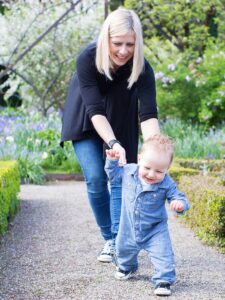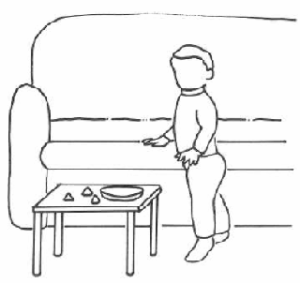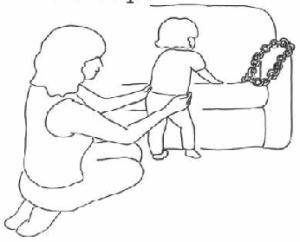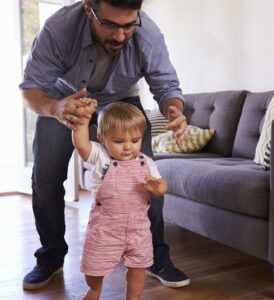/Our services (A to Z)/Physiotherapy (ICAN)/Developing your child’s movement skills: Standing and walking (ICAN)
Activities to develop standing and walking
Ideas and advice for parents and carers
General information

- Children with developmental delay sometimes take a long time to walk independently after they have learned to walk with support.
- It is harder for them to balance and co-ordinate themselves, as they do not get the same sensory information from their bodies, particularly if their muscles are very floppy.
- Every child is different so it is important to let your child guide you to the stage they are at. Persevere if they initially dislike an activity.
- Motivation is vital, so using toys, treats, fun and games can all help encourage them to do the activity you want.
- Physiotherapists DO NOT recommend babywalkers or bouncers for any children, particularly those with developmental difficulties or altered muscle tone.
- Babywalkers have been proven not to enhance development and may actually impair it.
- Please see separate babywalkers leaflet for further information.
Sequence
- Turning away from furniture using one hand to steady themselves
- Independent standing
- Cruising sideways along furniture with two hand support
- Walking with two hand support
- Walking with a push-along toy
- Walking one or two steps between supports
- Walking with one hand support
- Walking a few independent steps
- Walking indoors on even surfaces
Note:
- Children can miss stages out or they may stay at one particular level for a long time
- Work on a few activities together, for example, using a push-along and walking between two supports
- Give lots of opportunities to play and move in a standing position.
Footwear
Boot-style shoes from a good shoe shop will provide adequate support if your child is finding it hard getting the confidence to walk. Have your child’s feet measured properly for length and width. Avoid shoes which have very squashy soles and heel areas.
If your child is extremely flexible, a physiotherapist may refer to Orthotics to assess for supportive boots to help control foot posture while they are learning to stand and balance. These boots are not needed indefinitely and are not prescribed routinely.
Activities
Turning away from support
Turning away from support
Encourage
- Turning head to look for and reach a toy behind them
- Reaching between two pieces of furniture, place two pieces of furniture close together, position toys or treats on the other piece of furniture
- Gradually increase the distance between the furniture and encourage stepping between them

Squatting
- Encourage squatting down from standing.
- Child may initially hold on and reach down with one hand while standing.
- Their legs may stay straight, and they may fall down
- As muscle control improves, they will start to bend their knees to reach further, then stand up again.
Independent standing
- Let your child stand holding your hands, then you let go of them, once they have their balance.
- Encourage lifting both hands off the support to reach for toys
- Play games encouraging your child to balance while you count or sing a song
- They will usually be able to stand without support before they try standing up from the floor without holding on.
Cruising
Cruising

Position
- Support (for example, sofa) roughly at chest height
- Child should stand upright, facing forwards
- You give support at hips, guiding weight on to one leg to help your child free the other leg to step
- Help child position the leading leg out to the side, then guide them across to that leg. Allow, or help child to step the other leg across in the same direction
- Practice in both directions
Encourage
- Reaching sideways
- Stepping sideways, parallel to the surface
Play ideas
- Toys or treats positioned so your child has to reach for them
Climbing on and off furniture
- Help your child lift one leg up on to the sofa, and hold it steady while they work out how to pull themselves up (they may need help for this!)
- Most children feel more comfortable climbing down from furniture by going on to their tummy and sliding off until their feet touch the floor
- As they become more confident, they may try to slide off on in a sitting position
Walking with two hand support
Walking with two hand support

Encourage
- Holding your child’s hands at or below their shoulder level
- Child holds on to your hands, with you standing in front
- Use a towel or broom handle or hula hoop for your child to hold on to as their confidence increases
Walking with a push along toy

Position
- Use a solid, stable push along toy, approximately chest height and wide enough so child can step between wheels
Encourage
- Child to pull themselves up on walker
- Steady walker so it doesn’t “run away” with your child
- Walking on carpet rather than laminate or tile to begin
- Straight lines, clear area to walk in
Play ideas
- Playing shopping
- Collecting toys or bricks
- Pushing a baby or teddy
Walking between two supports
Walking between two supports
Encourage
- Stepping between 2 adults or an adult and sofa
- Start with only one step between supports, then increase
- Use treats or favourite toys to motivate child to step away from support
- Your child will probably prefer to walk towards you initially
- Give child lots and lots of encouragement to step away from the support

Walking with one hand support
Walking with one hand support
Encourage
- Hold your child’s hand at or below their shoulder level
- Child to reach forwards for your other hand which you hold in front of them
- Start in front of child then progress to walking at their side
- Confidence is a key part of developing this skill and will take time to be gained, sometimes over a few months

Walking independently
Walking independently
Encourage
- Gradually encourage child to let go of your hand
- Start by holding your hands just out of reach in front of child
- Start with just one step towards you or a support
- Increase distance as child’s balance improves
- Expect wobbly first steps, and child to fall into your arms after a couple of steps.
- Many children hold their hands up high to help them balance

Walking on even surfaces
- Practice walking on even surfaces, from house to car, in parks, supermarket, friend’s houses
- Child will learn to put their hands down to save themselves if they fall


